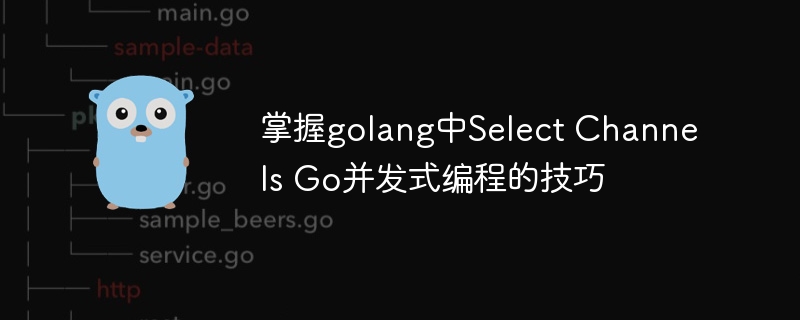Home >Backend Development >Golang >Master the skills of Select Channels Go concurrent programming in golang
Master the skills of Select Channels Go concurrent programming in golang
- 王林Original
- 2023-09-27 09:49:071325browse

To master the skills of Select Channels Go concurrent programming in golang, you need specific code examples
As computer performance continues to improve, more and more applications are beginning to Use concurrent programming to run more efficiently. As a language that supports concurrent programming, Go language provides a wealth of concurrent programming tools and mechanisms. Among them, the Select statement and channel (Channel) are important components of concurrent programming in Go language. This article will introduce how to use Select statements and channels to implement concurrent programming in Go language, and give specific code examples.
In the Go language, a channel is a data structure used to transfer data between Goroutines. Through channels, we can transfer and share data between different coroutines to achieve concurrent programming. The Select statement is a structure used to select channel operations and can handle operations on multiple channels.
The following is a simple example showing how to use channels and Select statements to implement simple concurrent programming:
package main
import "fmt"
func main() {
ch1 := make(chan int)
ch2 := make(chan string)
go func() {
for {
ch1 <- 42
}
}()
go func() {
for {
ch2 <- "Hello, world!"
}
}()
for {
select {
case <-ch1:
fmt.Println("Received an integer from ch1")
case <-ch2:
fmt.Println("Received a string from ch2")
}
}
}In this example, we create two channelsch1 and ch2, send integers and strings to the channel through two anonymous coroutines respectively. Then, in the main coroutine, we use the Select statement to select the operations of different channels. When data is received from the channel, the corresponding operations will be performed.
By running the above code, we can see that each time data is received from the channel, the corresponding operation will be executed. This is one of the charms of concurrent programming. By executing multiple tasks concurrently, we can achieve more efficient operation.
In addition to basic channel operations, the Select statement can also be used in conjunction with the timeout mechanism to avoid deadlocks in the program. The following is an example of using the Select statement and the timeout mechanism:
package main
import (
"fmt"
"time"
)
func main() {
ch := make(chan int)
timeout := make(chan bool)
go func() {
time.Sleep(2 * time.Second)
timeout <- true
}()
go func() {
time.Sleep(1 * time.Second)
ch <- 42
}()
select {
case <-ch:
fmt.Println("Received data from ch")
case <-timeout:
fmt.Println("Timeout")
}
} In this example, we create a channel ch and a timeout channel timeout. Through two anonymous coroutines, data and timeout signals are sent to the channel at different points in time. Then, in the main coroutine, select the operations of different channels through the Select statement. When no data is received from channel ch within 2 seconds, a timeout operation will be performed.
By running the above code, we can observe that if data is received from channel ch within 1 second, the operation of receiving data will be performed; if no data is received for more than 2 seconds to the data, a timeout operation will be performed.
Through the above examples, we can initially understand that concurrent programming in Go language can be achieved using Select statements and channels. In actual development, there are many other techniques and precautions that need to be mastered, such as using buffered channels to reduce synchronization overhead between coroutines, using work pools to control the number of concurrencies, and so on. I hope this article can provide you with some help, so that you can master the skills of Select Channels Go concurrent programming in golang, and be able to better apply it to actual development.
The above is the detailed content of Master the skills of Select Channels Go concurrent programming in golang. For more information, please follow other related articles on the PHP Chinese website!
Related articles
See more- How can you use Go's go fmt tool to format your code consistently?
- How can you use Go's sync.Pool to reuse objects and reduce garbage collection overhead?
- How do you write integration tests in Go?
- What are microservices? What are the advantages and disadvantages of using a microservices architecture?
- How do you use vendoring in Go?

